Rugby positions are defined by where players line up on the field during a scrum. Unlike some other sports, the numbers on player jerseys are specific to their position.
This article gives an overview of positions and roles in Rugby Union. We have links to in-depth articles on each position if you want to take a deep dive.
Other Types Of Rugby
This article is about Rugby Union, the version of the sport with fifteen players.
We have other articles on sevens rugby and touch rugby:
Rugby Union Positions By Number
Here is a diagram of how fifteen players are positioned on the field when they are awarded a scrum. We are showing the number on their backs and the names of the position.
It’s a lot to digest, so we’ll break it down by each position in the rest of the article.

Before we get down to the level of fifteen positions, let’s take a look at a more way basic way to categorize rugby players.
Forwards Versus Backs
The most basic way to categorize rugby positions is into forwards and backs.
In the diagram, the players numbered one to eight are forming a scrum. These eight players are the forwards.
The eight forwards use strength to push in the scrum and height to compete in lineouts. When they carry the ball, they run hard at opposition players to bash their way past them.
The players wearing nine to fifteen are the backs. The seven backs typically pass, kick, and run more than forwards. They seek to evade contact through agility.
Backs direct the attacking moves in open play and defend in wider positions.
The French like to describe the distinction as the piano shifters and the piano players. Forwards do the grunt work, while the backs bring the flair.
Usually, that’s a back talking!
Forwards, on the other hand, may take this view:

Eight Forward Positions
The forward positions get their names from their roles in the scrum.
When the forwards pack down against each other to form a scrum, they line up in three rows that also have specific names:
- front row forwards
- second row
- back row
This diagram shows how they line up in the scrum:
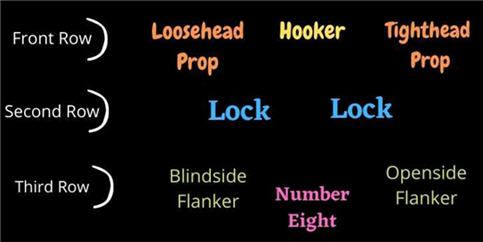
Loosehead Prop
The loosehead prop forward wears the number one jersey and packs down on the left of the front row.
Take a look at the front row in white jerseys in this overhead shot of a scrum. Note how the player with the number one jersey has his head pushing on the outer shoulder of his opponent.
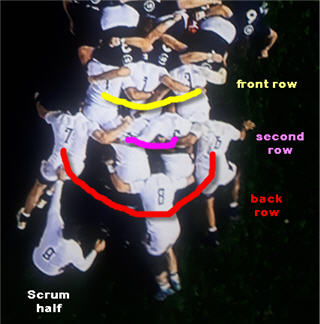
This prop’s head is “loose” as there is no opponent on the other side of his head. That’s where the term “loosehead” comes from.
The term “prop” comes from the role of propping up the scrum.
Aside from the crucial duties of the scrum, the loosehead is expected to contribute to ball carrying duties. This is often close to the ruck, where they take short passes and charge forward into traffic to gain vital yards.
The goal is to soak up multiple defenders and open up space for the faster players standing in wider positions.
Tighthead Prop
The tighthead prop forward wears the number three jersey and packs down on the right of the front row.
If you look back at the picture above, the number three jersey has his head wedged between two opponents. This is where “tight” comes in the name of the position.
The tighthead prop must battle the force of two opponents instead of one. They are often the strongest players on a rugby team. That also means that ball carrying is a key part of their role.
As the two props are heavy, they don’t jump in lineouts. Instead, their role is to lift the lighter forwards.
If you want to learn more, we have an in-depth article on loosehead and tighthead props in rugby union.
Hooker
The hooker wears the number two jersey and packs down in the middle of the front row. The hooker has a vital role in the scrum and in lineouts.
In a scrum, the hooker nudges the ball backward to the number eight at the back. This is known as “hooking” the ball and it’s how hookers get their name.
Hookers also throw the ball into the lineout in modern rugby. We have an in-depth article on hookers in rugby union.
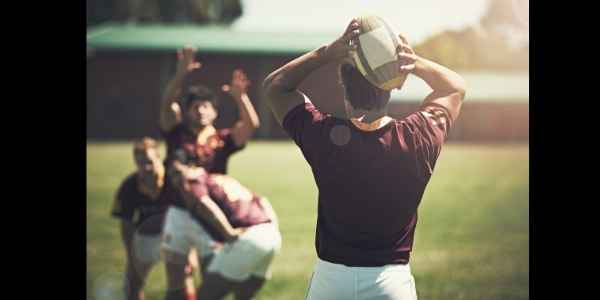
Second Row Positions: The Locks
The two players in the second row are known as lock forwards or simply locks.
One lock wears the number four jersey and the other lock wears number five.
When locks pack down in the scrum, they grip onto the props in front of them (this is known as binding).
Their role is to both push forward and to keep the scrum stable. This is known as “locking” the scrum, and it’s where they get their names.
Locks are also the players most likely to jump and catch in the line out. That’s why they are the tallest players on the pitch. Lineout jumping may seem simple, but there is a huge amount of skill in timing the leap with the cadence of the hooker’s throw from the sideline.
We have an in-depth article on locks in rugby union.
Back Row Positions In Rugby
The three players in the back row of the scrum are the:
- blindside flanker
- openside flanker
- number eight
The flankers wear the number six and number seven jersey. The blindside flanker usually wears six and the openside flanker wears seven.
Flankers
The terms “blindside” and “openside” refer to how much distance there is from each side of the scrum to their nearest touchline. The side with the most distance is the openside, and the blindside has the least distance.
When the back three players pack down in the scrum, the openside is on whichever side has the most space.
Although strong, the flankers tend to be the lightest and fastest forwards in the team. Their role is to follow the ball around the field.
In attacking play, they should be be available to take a pass and give one. This role in support play means they should have good handling skills. They are also required to protect the ball when the ball carrier is tackled to the ground.
Their role in defensive play is to compete for the ball to try to win possession or at least slow down the attacking flow of the opposing team.
There are subtle differences between the blindside and openside positions which we explain in our article on the roles of flankers.
Number Eight
The number eight is the only player in a rugby team that doesn’t get a catchy moniker!
In the United States, the position is sometimes referred to as the “eight man” but that hasn’t caught on in other parts of the world.
This player has a vital role at the back of the scrum, which we explain in our in-depth article on the role of the number eight.
Aside from the scrum, the back row also have important roles in open play.
They must support the backs by taking and giving passes during attacking moves. They are also key at protecting possession of the ball when a teammate is tackled.
Of course, the opposition back row players are trying to steal the ball at the same time. We go into this part of the sport in our article on rucking.
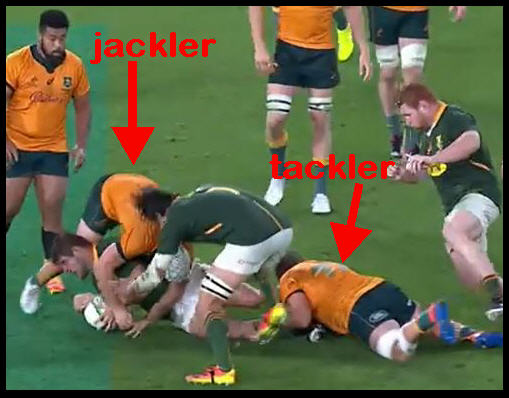
Half Backs As Rugby Positions
“Half back” is a relatively old-fashioned term but you’ll still hear it being used to describe the scrum half and outhalf pairing.
These two backs stand closest to the scrum.
Confusingly, these rugby positions have several names. The scrum half is also known as the nine. The outhalf is also called a fly half. Let’s take a closer look at each position in turn.
Scrum Half
The scrum half wears the nine jersey.
As you would expect from the name, the player has a very specific role at scrum time. They feed the ball down the middle of the two packs and move to collect it from under the feet of the number eight.
Scrum halves also follow the ball around the pitch. They are specialists at passing the ball after their teammate has been tackled to the ground.
We have an in-depth article on the role of the scrum half in rugby union.
Outhalf / Fly Half
There are more names for the player who wears the number ten jersey than any other position.
The outhalf directs the attack in open play by receiving the ball from the scrum half and making the critical choice of what to do next: pass, kick, or run.
The outhalf or fly half is the main kicker on the team. They often take all the penalty and conversion kicks for their team. Their success can be the winning and losing of a game.
Just as importantly, the fly half is chiefly responsible for kicking in open play. A fly half must have a good kicking game with several strategies:
- kicking diagonally across the pitch to put the ball deep into opposition territory
- high kicks that give the rushing back line players the chance to jump and compete
- defensive kicks to get the team out of trouble when deep in their own half
Good passing skills are also vital. In attacking play, the fly half directs play around the field in order to create space for attacking opportunities.
We dive deeper into this vital role in our in-depth article on the outhalf or fly half in rugby union.
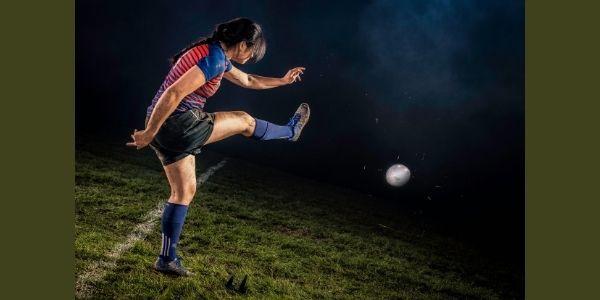
Centres
There are two centres in a rugby team. They wear the twelve and thirteen jersey.
The number twelve is typically known as the inside centre. This player stands closer to the outhalf.
The number thirteen is typicallly known as the outside centre. This player stays further wide in attack and defense.
In the early history of the sport, rugby involved a large mass of men surrounding the ball-carrier and heaving backward and forward.
The addition of centres positioned in the middle of the field gives us the open play of the modern sport.
A typical attacking move is to pass the ball from the outhalf through the hands of both centres with the outside centre giving the final pass to the winger near the sideline.
Centres will also look for an opportunity to break through the defensive line with a sidestep. They will also seek an incisive line through a small gap – this is known as running direct lines
There are subtle differences in attack and defense for the twelve and thirteen. We go into this in more detail in our article on the roles of centres in rugby union.
Wingers
There are two wingers in a rugby team. They are typically positioned nearest the left and right touchlines.
The left winger wears the eleven jersey and the right winger wears the fourteen jersey.
Wingers often play both left and right throughout their career. In general, left-footed players tend to be on the left wing to take advantage of a stronger kicking action up the left touchline.
There are other subtle differences between the two positions. We do into more details in our article on the role of wingers in rugby union.
Both wingers are expected to be excellent at receiving a pass and using speed and footwork to evade defenders and get over the tryline for five-point scores.
This can be some of the most exciting parts of rugby.
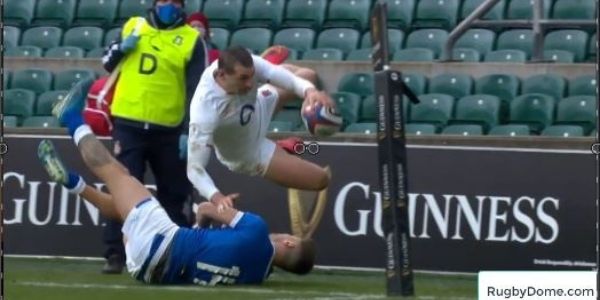
Fullback
Well, we’ve finally got to the last position on the field. This player is also furthest back from his teammates. This is why the position has the name of fullback.
Fullbacks are particularly noticeable when the opposition uses a strategy of kicking long high balls into the backfield of their opponent.
The fullback is a specialist at jumping and catching a high-dropping ball. Meanwhile, the opposing fullback may have raced forward to jump and catch the same rugby ball!
Fullbacks must have a strong kicking game to make deep kicks into opposition territory. Many fullbacks are “converted” out halves.
There are several elite professional players who can switch between the ten and fifteen positions even at international level. Beauden Barrett does this with the All Blacks.
As the last line of defence, fullbacks are also key defenders who must constantly scan the field for threats when the opposition has the ball. If an opponent breaks through the defensive line, its up to the fullback to track across and to make the final tackle.
Check out our article on the role of fullbacks in rugby union for a more in-depth look.
Frequently Asked Questions
Here are some quick answers to common questions about rugby player positions.
What rugby positions get cauliflower ears?
Cauliflower ear is developed from frequent rubbing and chafing of the ears in the scrum.
This means that forwards are most likely to develop cauliflowers.
Many take protective action against this! Check out our article on why rugby players tape their ears!
What positions score the most?
In general, wingers score the most amount of tries in rugby.
This is illustrated by the chart below that shows the average number of tries scored by position in the 2019 World Cup.
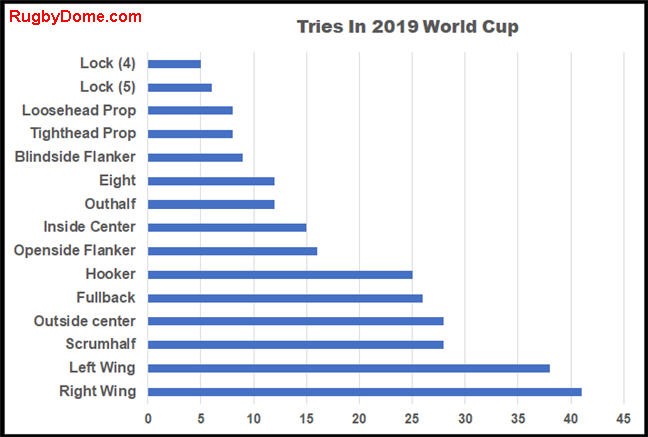
What position is the easiest?
If you’re starting out in rugby, we recommend that you play on the wing for your first few matches. This tends to be the easiest position for beginners.
Why? Basically, wingers make a low amount of tackles and don’t get involved in complex formations like the scrum or lineout.
We explain more (and give other options) in our article on the easiest position in rugby.